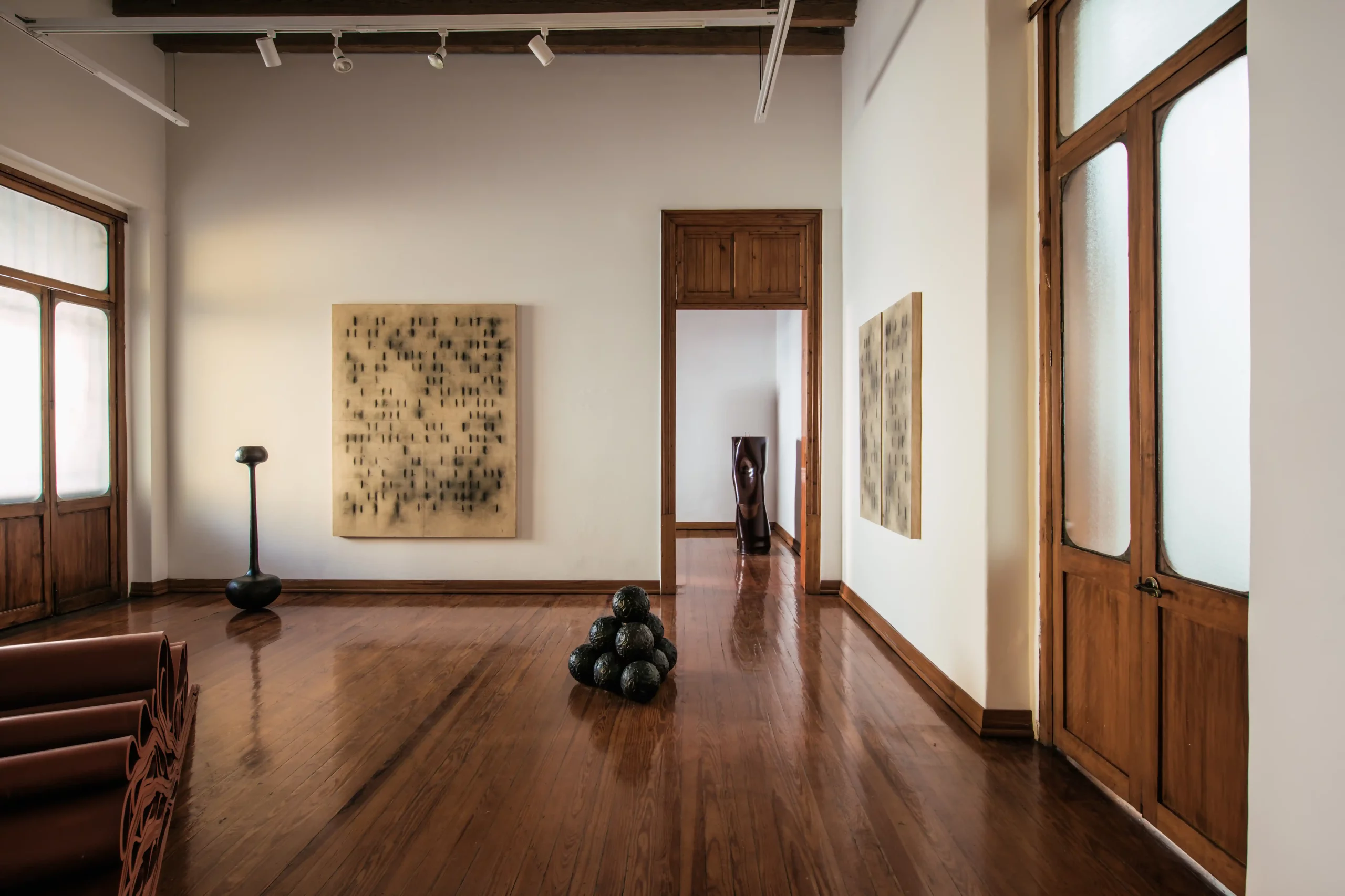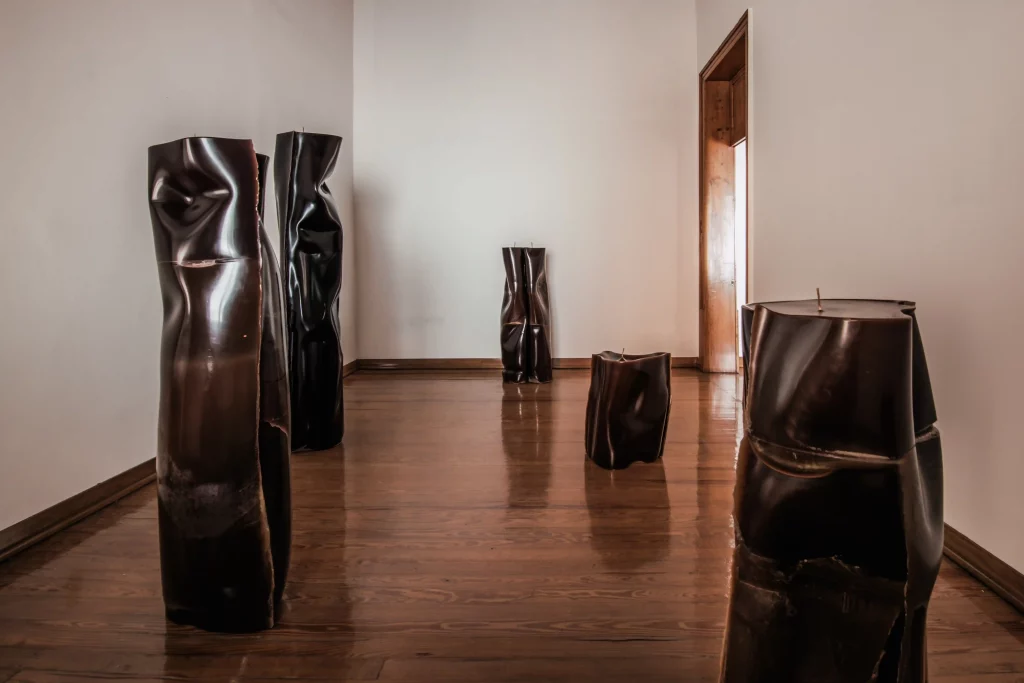Founded in 2019 by Brian Thoreen, Age Salajoe and Hector Eraswe as a nomadic gallery – now a permanent space in the house that was formerly the residence of Federico Sanchez Fogarty
Non-Zero-Sum at MASA Gallery
The contact zone where art meets design and the functional merges with the non-functional has been a career long fascination for Brian Thoreen. The works that he has produced in the past few decades are united by this thread, at times overt and at other times as a subtle undercurrent. The exhibition Non-Zero-Sum at MASA Gallery in Mexico City is the first occasion that all of these works have been brought together. «It was an opportunity to collate all of the projects of the last few years and so reflect on them», recounts Thoreen. Sixteen works are exhibited in a diversity of materials and forms that break with convention.
Brian Thoreen, Age Salajoe and Hector Eraswe
Thoreen’s decision to exhibit as MASA was motivated by a number of factors. The first was his relocation to Mexico City after years of living between LA and NYC. «It felt right to move to Mexico, there is such a rich culture that combines with the generous nature of the people». In Mexico City, Thoreen immersed himself in the artistic community and this in turn gave rise to the foundation of MASA Gallery.
The gallery was founded in 2019 by Thoreen, together with Age Salajoe and Hector Eraswe as a nomadic gallery but now takes a permanent space in the 17th century colonial house that was formerly the residence of the art patron Federico Sanchez Fogarty (1901- 1976). «Masa gallery was crafted as a collaborative experiment».
The earliest shows were group exhibitions with a number of contributors, and Thoreen’s exhibition is one of the first two solo shows at MASA as a means to test the ground and to make use of the expansive exhibition space. Together with Marcia Garcia Torres’ exhibition The Space Under My Chair & The Music I Was Listening to, the new gallery aligns with the avant-garde and open spirit of Mexico City’s cultural milieu.
Brian Thoreen: where contemporary art and carpentry meet
After starting to work creatively while at college in California, Thoreen subsequently became a studio assistant, working with a number of the key players on the contemporary art scene. Yet after a while, Thoreen felt he «had hit a ceiling – the interest was more on architecture and design». And so, he got a job as a carpenter and trained in the skills of working directly with materials. This marked a shift from working with art to design and in turn to architecture. «Twenty years ago, these fields were distinct» and in turn Thoreen has over the years worked to bring them together.
«I experimented with developing my own language» explains Thoreen «as I saw that the two worlds of art and design wanted to merge». In his early shows from around 2014, «Things were building conceptually». Yet Thoreen also saw that he was mainly managing production. Instead, he wanted to be more involved and work in the studio. Over the past 5 years he has been developing projects that have led to the current exhibition.
A venn diagram as the crossover between object and artwork
The distinction between art and design is one that has been explored by various creators over the past century. These range from Donald Judd, who as much as he was an artist also designed furniture to Isamu Noguchi who was a sculptor and an architect and who adopted different languages when creating either functional or non-functional pieces.
The question of what draws the line is one tied both to history and logistics. It is in some respects an easy dividing line: if you can use it then it is an object, if it serves a purely aesthetic purpose, then it is an artwork. Yet, as Thoreen points out «if you can consider how art developed through form, function and concept, these factors can in turn be related to furniture and so the essential dividing line is function». This crossover between object and artwork can in a way be seen like a Venn diagram: «there is a grey area that you can play with and prod at».
Roland Barthes: The Death of the Author
To follow the argument of Roland Barthes, there is the concept of The Death of the Author where it is the viewer or user who dictates the category into which an object or artwork falls. Yet for Thoreen, he believes that intent is key; that a creator makes something with a specific purpose – functional or non-functional – in mind. The viewer or user also has a perspective on how they perceive the work and so this dynamic is not mutually exclusive. This is also affected by use.
For instance, Thoreen makes candles of two metres in height that serve as sculptures, where the key dividing line is whether or not someone decides to light the candle wick. «The function is hidden inside through a wick, yet on the surface they are a sculpture». In turn, that also challenges perceptions on the nature of beeswax by presenting it as an art form to be observed in detail.
Visual and functional: Brian Thoreen’s recent work
These themes are brought together in Thoreen’s most recent work – a Triptych of works on paper drawn with charcoal. The inspiration was the earliest wall paintings but also coding. The marks made contain binary code that have been subtly blurred and therefore the work is both «visual and functional» even though this data has been scrambled. Therefore there is a meaning even if Thoreen «does not see them as functioning pieces, there is an underlying purpose».
One key aspect of this triptych was to engage with the environmental and social issues of data storage and to do so in an aesthetic way. «It is meant to be all manner of things – analogue and digital at the same time as was functional and non-functional and therefore references so many aspects all at once». Though it is quite different to the rest of his work, it conceptually brings everything together.
The tactility of rubber
Thoreen works with both manmade and natural materials, with the uniting thread that dictates what he decides to use being «materials that exist best in the world around us». Over the years, rubber has been one that he has frequently returned to after first making a rubber credenza. Key to his interest in rubber is the tactile element in addition to the fact that it is «a standard industrial material that can be used in any context».
Coffee tables were made from rings of translucent rubber that have a similar effect to alabaster and are inspired by early French deco. There is a continued inspiration «from the effect of the light» yet there is also an interest in how the material behaves. For instance, he has done vertical and horizontal experiments into rubber’s characteristics with one outcome being a rubber chair that is made from two tonnes of rubber folded and stacked on the ground to create a seat.
Brass, bronze, copper and beeswax
Metals including brass and bronze also frequently appear in Thoreen’s work. Some of the earliest man made alloys, he is interested in the way that «they get better with age». Copper serves a structural purpose as it can be used to construct forms and shapes in order to give structure. These metals are also combined with beeswax in his sculptural candles in a «play with rudimentary materials». Uniting all of these works is an awareness of how long things last. For him, the «most environmentally friendly are those materials that last and that can be used and reused». For instance, neoprene rubber does not need to be thrown away and can be repurposed. «Longevity is key», Thoreen notes.
MASA Gallery, Mexico City
Joaquín A. Pérez 6, San Miguel Chapultepec I Secc, Miguel Hidalgo, 11850 Ciudad de México, CDMX, Mexico. MASA Gallery was founded by Brian Thoreen, Age Salajoe and Hector Eraswe in 2019. The contemporary art gallery is located in Mexico City.




















